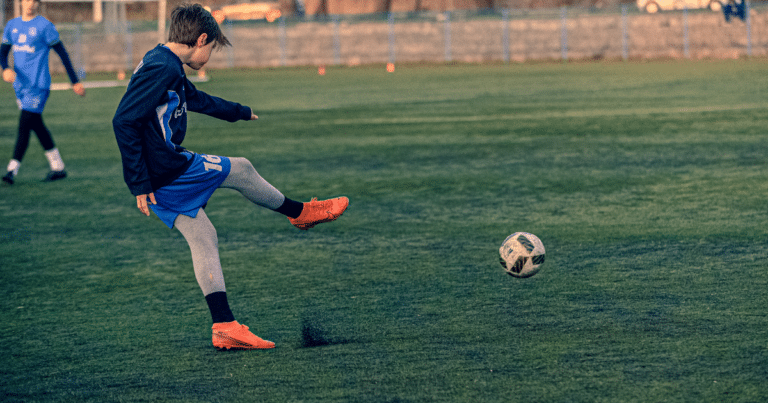The Underappreciated Through Ball
A through ball in soccer is a pass that goes between defenders to a teammate running toward the goal. This special pass helps teams score more goals and is one of the most exciting plays in soccer.
TL;DR:
What Is a Through Ball?
When you watch soccer, you might see a player kick the ball between defenders. The ball rolls into open space, and suddenly a teammate appears, racing to get it! This is a through ball – one of soccer’s most exciting passes.
Through balls happen when one player sees a gap between defenders. They kick the ball through this gap to a teammate who is running forward. When done right, it can lead to a great chance to score!
I think through balls are the most beautiful part of soccer. Nothing is more exciting than watching a perfect pass split the defense and lead to a goal.
How to Make a Good Through Ball
Timing Matters!
The most important thing about a through ball is when you pass it. Pass too early, and your teammate won’t be there yet. Pass too late, and defenders will block it.
You need to watch where your teammate is running and where the defenders are standing. Then, kick the ball at just the right moment. It takes practice, but it’s worth it!
Be Super Accurate
Your through ball needs to go to the right spot. If the ball is too far ahead, your teammate can’t reach it. If it’s behind them, they’ll have to slow down, and defenders will catch up.
The best through balls roll right into your teammate’s path, so they can keep running at full speed toward the goal.
Play Fast!
Soccer moves quickly! When you see a chance for a through ball, you need to act fast. Defenders work hard to close gaps, so you only have a split second to make your pass.
In my experience, the best players don’t hesitate – they see the opportunity and take it right away.
Different Types of Through Balls
Ground Through Balls
These are passes that stay on the ground. They’re the most common type of through ball. The ball rolls along the grass between defenders.
Ground through balls are great because they’re easier to control. Your teammate can run onto the ball without having to worry about it bouncing.
Air Through Balls
Sometimes, you need to lift the ball over defenders. These are called air through balls or lofted through balls.
Air through balls are harder to make but can be super effective when defenders are crowded together. The ball flies over their heads and lands where your teammate can reach it.
Split Through Balls
When you pass the ball between two defenders who are standing close together, that’s a split through ball. These passes need to be very accurate!
Split through balls are exciting because they create a direct path to the goal. If your teammate gets this pass, they might only have the goalkeeper to beat!
Why Through Balls Are Important
Breaking Down Defenses
Soccer teams work hard to build strong defenses. Through balls help break through these defenses by finding gaps between players.
Even the best defense can be beaten by a perfect through ball. That’s why teams practice this pass so much!
Creating Scoring Chances
The main reason to use a through ball is to create chances to score. When your teammate gets past the defenders with the ball, they’re much more likely to score a goal.
Through balls often lead to one-on-one situations with the goalkeeper, which are great scoring opportunities.
Keeping the Ball
Through balls also help teams keep possession of the ball. By passing through the defense, you make the other team chase the ball instead of taking it from you.
This can tire out the other team and give your team more control of the game.
Who Makes Through Balls?
Midfielders
Midfielders make the most through balls. They stand in the middle of the field and can see both their teammates and the defenders. This helps them spot good opportunities.
Many famous midfielders are known for their amazing through balls that lead to goals.
Forwards
Forwards usually receive through balls, but they can make them too! Sometimes a forward will pass to another forward who has a better chance to score.
Fullbacks & Wingbacks
Even defenders can make through balls! When a fullback or wingback (defensive player on the side) moves up the field, they might see a chance to pass through the defense.
These passes can surprise the other team because they don’t expect defenders to make attacking passes.
Start Practicing!
Through balls are an amazing skill that can make you a better soccer player. They take practice and good vision, but anyone can learn to make them.
Next time you play or watch soccer, pay attention to through balls. Notice when players make them and how they lead to exciting plays!
Remember, soccer is about having fun and working with your teammates. Through balls are a perfect example of how teamwork makes the game beautiful!

Written By: SoccerNovo
SoccerNovo is an independent youth soccer media brand built to help parents, players, and coaches better understand the game and the pathways available in U.S. soccer. Our mission is to make youth soccer simpler, clearer, and more accessible for everyone involved in it.
Let’s connect




